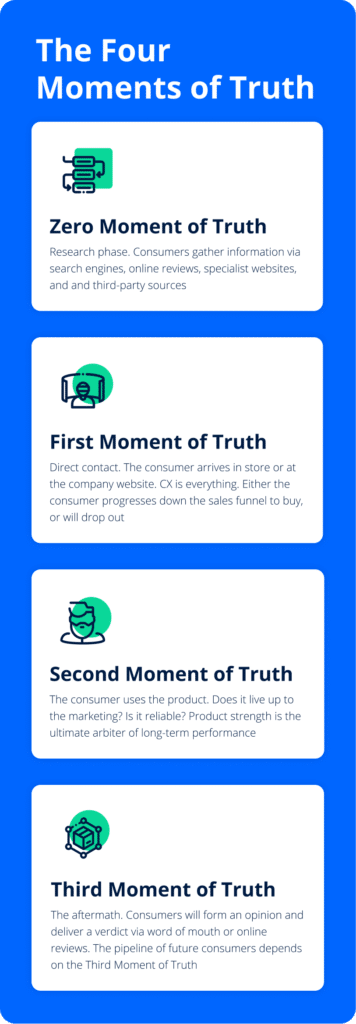
By Kyla Reed - May 21, 2025
Closing the UK SME Gap: Tech-Driven Solutions for the “Missing Middle”
Discover how open banking, AI-powered automation and API-first banks are closing the “missing middle” in UK SME lending—slashing funding times
Consumer brands rely on a sequence of touchpoints known as the FMOT. Here is the essence of the philosophy, and why insurers need to embrace the concept.
At FintechOS we help insurers deliver superb customer experiences. Our methodology is a vital part of this. We supply technology to banks, but it is our understanding of the customer experience (CX) that makes us stand out.
A necessary part of mastering CX is to map out the customer journey. This is necessary in order to understand what each person goes through when buying a product, from the first idea and research, to acquisition, usage, and ultimately, repeat purchases.
The best way to do this is to break the customer experience into Four Moments of Truth. This is a mainstream model, originally devised by Jan Carlzon in the 1980s. As CEO, Carlzon transformed Scandinavian Airlines System into one of the most admired and customer-centric operations in the world. His idea was developed by AG Laffley, legendary chair of Procter & Gamble, and today underpins the marketing strategy at P&G.
Moments of Truth is endorsed by many leading companies, including Microsoft and Google – which argues the FMOT “matters now more than ever”.
Insurers are less engaged with the philosophy. This needs to change. Customers compare experiences across sectors. Amazon, Google, and P&G set the bar. Comparisons are made across sectors – there is no exemption for financial services.
To improve the customer experience, and optimise the sales funnel, insurers need to understand this core marketing concept.
Zero Moment of Truth
Before customers buy, they research. The Zero Moment of Truth describes the pre-sales phase, when customers conduct their own broad scan of the market. This involves search engines, online reviews, specialist websites, and an array of third-party sources.
The concept of a Zero moment came courtesy of Google in 2011, as a prequel to P&G’s three steps. Google abbreviates Zero Moment of Truth to ZMOT.
The ZMOT is of special interest for Google, as the Google search bar is the most common starting point for consumers in their quest for information.
What does ZMOT mean for insurers? It is the first chance to engage with consumers, who will develop views, which may become entrenched, within minutes of beginning research.
Search Engine Optimisation (SEO) is what matters at this juncture. Which brand names appear at the top of a search request for keywords? If a consumer is looking for a home & contents policy, they may never get past the first five Google results. The old joke: “The best place to hide a dead body is page 2 of Google search results” makes the point.
Review websites are a common destination for Zero Moment research. In the UK, advice website MoneySavingExpert attracts 16 million users a month. The founder’s newsletter reaches 7.5 million subscribers. For many British customers, the first (and lasting) opinion a consumer forms of an insurance brand will occur on this website.
The job of insurers is to map out the ZMOT landscape. How are consumers conducting early research? How does the brand and product line look on these third-party sources? Are there negative issues to resolve – such disgruntled consumers leaving one-star reviews or blog posts? Without a positive Zero Moment there may be no further Moments.

First Moment of Truth
Direct contact is the First Moment of Truth. In bricks and mortar, this is when the consumer arrives at a branch. In digital, it is when the consumer clicks on the company website. Now the dialogue is one-to-one: brand to the consumer.
Procter & Gamble narrows the FMOT to a single focus: “when a consumer stands in front of the shelf and chooses a product from among many competitive offerings”.
Other brands see the FMOT as a series of key moments. There is the first time a consumer looks at the website. First browse of the product section. The decision to buy (or exit) can be made at any of these journey points.
The science of optimising the sales funnel is now two decades old, and a vast arena with endless sub-specialities. Randomised multivariate and A/B testing is a great example. Facebook famously tested 41 shades of blue to find the “stickiest” shade. For the 2010 US election, Facebook randomly divided American users into three segments, with a differing “get and and vote” message. The startling results triggered accusations that Facebook can “control elections” – marketers noted the power of multivariate testing.
Insurers are widely regarded as laggards in the field. Regulatory obligations around marketing and innovations, compounded by natural reluctance to experiment with something as critical as financial services, led to a historic under-exploration of the power of multivariate testing. Furthermore, insurers are often reliant on outmoded CX technologies which make it hard for marketers to understand and address the First Moment of Truth.
Lately, insurers are adopting no-code/low-code interfaces to put managers back in control of CX, including customer journey sequences, to improve performance around the First Moment of Truth. Guiding consumers to the end of the sales funnel takes experimentation, creativity, and responding to feedback: achievable with no-code/low-code interfaces.
Second Moment of Truth
The initial use of a product is the Second Moment of Truth. It’s the feel of the packaging. Opening the box. And the initial session with the product, be it a mobile phone booting up, or the first bite of a pizza. Consumers make their minds up very quickly.
For insurers the Second Moment of Truth is a potentially lifetime defining interaction. A consumer will call the insurer with a claim, and the response from an insurer will either re-assure the consumer – or drive them to despair.
Expectations are low: a survey by the Geneva Association across six major economies revealed only 21% of consumers believe their insurer to be “trustworthy”. Two-thirds agree their insurer will “do anything” to avoid paying out for a legitimate claim.
The Edelman Trust Barometer 2020 offers great insights into why some brands are trusted. Dependability – beloved of engineers – ranks low, rated by just 15% as a key driver for trust. The top two elements are ethics (76%) and integrity (49%). The Second Moment of Truth is thus defined not merely by what products banks and insurers deliver, but their ethos and messaging around that delivery.
To improve the Second Moment of Truth insurers should respond to these worries and give consumers autonomy over their experience. Self-service should be possible: with easy access to documentation, billing information, and self-service updates. Policy renewals should be doable with the minimum number of steps. Customers should feel in charge of their digital experience.
The First and Second Moments of Truth are inextricably linked. As P&G put it: “Winning at the first moment of truth gives us the chance to win at the second. Winning at both moments of truth – time and time again – is how P&G grows.”
Third Moment of Truth
The final, and Third Moment of Truth, is how customers behave after experiencing a product. It’s the word-of-mouth effect: whether In Real Life (IRL) or online. According to Nielsen, 92% of consumers believe recommendations from friends and family over all other forms of advertising.
Online consumer reviews are important too. Nielsen data shows across 56 countries, 70% of consumers trust the reviews they read on the internet.
Managing the Third Moment of Truth is vital for marketers. Post-sales conversations can be improved with simple interventions. Follow up messages to ensure the consumer received all they needed can reinforce a caring image. Inducing customers to leave feedback helps. Reviews designed to sabotage a brand can be removed.
Furthermore, online reviews are a goldmine for marketers. Frank feedback can help marketers and product teams iron out kinks in CX and product design. There is quantitative and qualitative data on product performance.
How to master the Four Moments of Truth
Banks and insurers face higher scrutiny than ever. Consumers expect their financial service providers to meet the CX standards set by tech giants, who invest billions in optimising their interfaces. The mobile app must be as intuitive as Airbnb. The search interface ought to be as fast as Google. And the customer service as strong as Amazon.
Segmenting the customer journey into the Four Moments of Truth allows banks and insurers to think about the journey in a manageable, and ultimately practical way. Invisible touchpoints can be discovered. Critical moments can be given the care and attention they deserve.
The Four Moments of Truth matter, because they matter to customers. A brand with a strong focus on these flashpoints will be customer-centric, able to view internal processes just as the customer sees them.
Master these moments, and the result is receptive, willing, content, and ultimately evangelical customers, who’ll advocate the brand to the next generation of consumers.
***
MAIN PHOTO Credit: Unsplash